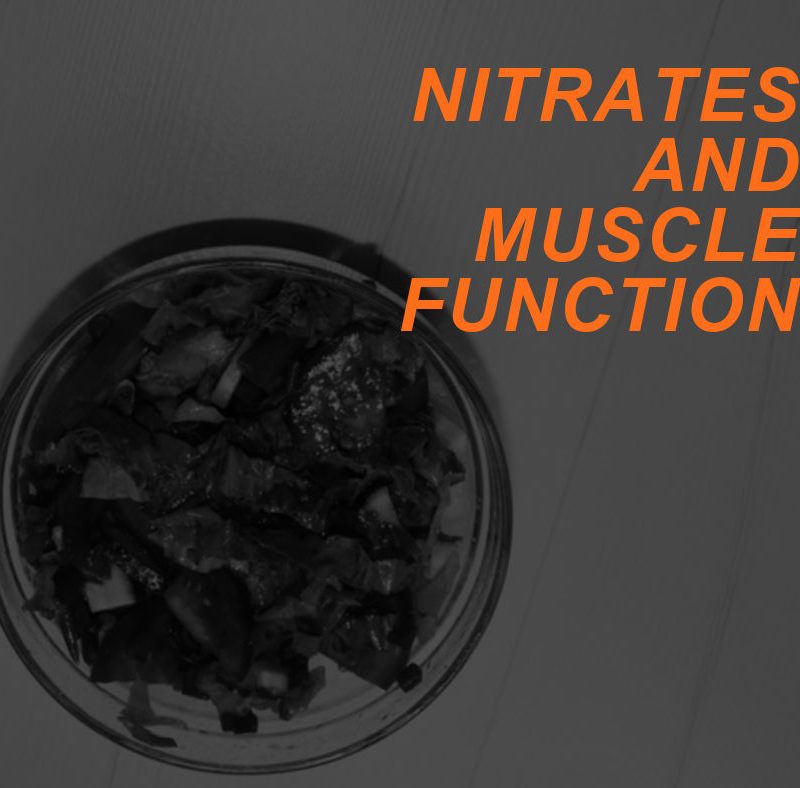
Could dark green leafy vegetables soon join the list of elite pre/post-workout muscle fuel? Read on to learn how natural sources of nitrates can foster better muscle contractile properties, lower blood pressure, and so much more!
Biological Breakdown: Nitrates vs Nitrites
Nitrates (NO3) consist of one nitrogen atom and three oxygen atoms, while nitrites (NO2) contain one nitrogen atom and only two oxygen atoms. Nitrates occur in nature as “inert” (stable) molecules unlikely to elicit harm. The body’s enzymes, however, can convert them into nitrites; herein lies the double-edged sword. Nitrites can either turn into beneficial nitric oxide, or nitrosamines, the culprits responsible for harming health.
In-depth toxicological investigative studies have yet to demonstrate a convincing relationship between nitrite exposure and carcinogenesis, leading scientists to question whether all food sources of nitrate threaten our well-being.
Maximizing Muscular Contraction
New research from Edith Cowan University, published in the prestigious Journal of Nutrition, extolls the virtue of diets heavily focused on vegetables. Scientists linked the abundance of naturally occurring nitrate in several common dark green leafy vegetables to the reported improvements in muscle function, most notably in the legs.
One such study from Australia, culling data from over 3700 participants during a 12-year period of time, found that diets including a plethora of dark green leafy vegetables (a rich source of nitrate) elicited 11% greater lower limb strength and up to a 4% increase in walking pace than meal plans containing less vegetable-sourced nitrate. These subjects’ grip strength, too, jumped up by 4%, as compared to their non-greens-eating counterparts.
According to one study, humans obtain ~80% of their dietary nitrate from vegetables, with lettuce, spinach, kale, and even beetroot topping the list. Lead researcher Dr. Marc Sim also mentioned the added bonus of all the minerals/vitamins biologically available to the body through greens, as opposed to a daily nitrate capsule.
The Great Nitrate Debate
Food producers often add nitrates and nitrites to processed meats (bacon, ham, sausages, and hot dogs). These compounds enhance the products by contributing highly palatable salty flavor and the pinkish-red color we commonly associate with “processed lunch meats”.
Research put out by the American Institute for Cancer Research, entitled Food, Nutrition, Physical Activity, and the Prevention of Cancer: a Global Perspective, heralded the following recommendation: “Limit consumption of red meats (such as beef, pork, and lamb) and avoid processed meats”.
Current guidelines suggest that individuals may safely consume up to 500 grams of red meat (the equivalent of 18 ounces) over a 7-day period since fresh meats contain neither nitrite nor nitrate.
While extensive toxicological investigative studies report that regularly consuming processed meats may lead to various digestive tract cancers, including colorectal cancer, review panelists could not determine a safe consumption level for the product(s). Thus, experts continue to question whether all food sources of nitrate threaten our well-being.
Factory or Farm-Raised?
Laws today ensure that manufacturers limit the amount of nitrites used when processing meats, owing to the potential health hazards of excess nitrosamines. However, natural and organic ways of preserving meat often include celery salt, which also may contain nitrates. Cautious bacon aficionados may consider the following:
- Buy products locally or from farmer’s markets
- Find a supplier of bacon from pasture-raised pigs
- Fry or cook bacon at reduced heat for a longer amount of time, avoiding burning
Nitrates and Blood Pressure
A Danish study encompassing 53,150 participants delved into how regular consumption of nitrate-rich leafy vegetables might affect blood pressure. A follow-up after 23 years revealed that higher nitrate consumption did in fact correlate to lower diastolic and systolic blood pressure readings. Some speculation exists as to whether the lower blood pressure or the nitrates themselves rendered the individuals “healthier” since these subjects also demonstrated a decreased incidence of ischemic heart disease/stroke, heart failure, and hospital stays resulting from peripheral artery disease.
Leafy Additions to the DASH Diet
The Dietary Approaches to Stop Hypertension (DASH) studies found that diets rich in vegetables (8–10 servings/day) and low-fat dairy products can help decrease blood pressure, with results akin to those obtained by taking a single blood pressure medication. The blood pressure–lowering effect of the DASH Diet, originally attributed to high levels of naturally-occurring calcium/potassium/fiber/polyphenols, may actually hail from the inorganic nitrate inherent in certain vegetables. This compound can provide a substrate for reduction to nitrite, nitric oxide, and other metabolic products, which in turn foster vasodilation, decreased blood pressure, and improved cardiovascular function.
The World Health Organization suggests limiting nitrate intake to 222 mg /day for a 60-kg adult. Following a DASH dietary pattern with high-nitrate vegetable and fruit choices would exceed this by 550%. Even a single serving of spinach can exceed the recommended adult daily intake for nitrate. The fact that typical consumption of vegetables/fruit seems in excess of current guidelines points to the need for professionals to re-evaluate such limits, acknowledging potential health benefits.
Take-Home Messages
When your health and fitness clients seek advice/opinions on the risks and benefits of favorite foods, you can offer the following statistics garnered from research studies. Many fitness health experts and sports dietitians currently steer clients towards easing into a more plant-centered meal plan; as we have learned, the benefits can extend far beyond the confines of one’s gym!
- Ingestion of nitrate, found in green leafy vegetables and beets, increases the production of nitric oxide (NO), a vasodilator with the potential to lower steady-state oxygen uptake during submaximal exercise, especially in fast-twitch type 11 muscle fibers.
- NO3− (dietary nitrate) intake improves muscle contractile function among healthy young and middle-aged individuals, athletes, those suffering from cardiac ailments, and the elderly.
- Dietary nitrate may enhance muscle blood flow during exercise, thereby facilitating endurance.
- Nitrate intake from vegetables shows an inverse relationship with vascular disease-related mortality, independent of lifestyle and cardiovascular disease risk factors.
References:
https://academic.oup.com/jn/article-abstract/151/5/1222/6184158?redirectedFrom=fulltext
https://www.sciencedaily.com/releases/2021/03/210324132309.htm
https://pubmed.ncbi.nlm.nih.gov/30907070/
https://pubmed.ncbi.nlm.nih.gov/28566306/
https://pubmed.ncbi.nlm.nih.gov/33884541/
https://www.ncbi.nlm.nih.gov/pmc/articles/PMC6138552/
https://pubmed.ncbi.nlm.nih.gov/23070702/
https://pubmed.ncbi.nlm.nih.gov/26447563/
https://www.gssiweb.org/sports-science-exchange/article/sse-110-dietary-nitrate-the-new-magic-bullet-
https://www.healthline.com/nutrition/are-nitrates-and-nitrites-harmful
https://academic.oup.com/ajcn/article/90/1/1/4596750
https://pubmed.ncbi.nlm.nih.gov/18268290/
https://pubmed.ncbi.nlm.nih.gov/9099655/
https://pubmed.ncbi.nlm.nih.gov/16563818/








